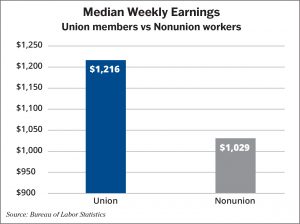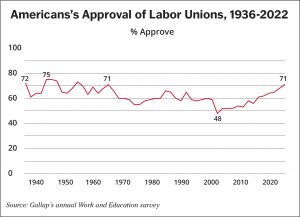 The U.S. Bureau of Labor Statistics’ annual Union Members report proves what many CSEA members already know – that it’s better to be union.
The U.S. Bureau of Labor Statistics’ annual Union Members report proves what many CSEA members already know – that it’s better to be union.
The report, released January 19, shows that labor union members make 15% more than nonunion workers in similar jobs.
Unionized workers had median weekly earnings of $1,216, as opposed to $1,029 for nonunion workers, a difference of $187 per week and an annual difference of $9,724.
The summary also showed that the union membership rate of public sector workers is more than five times higher than the rate of private sector workers. Specifically, 33.1% of public sector workers are union members, while only 6% of private sector workers are unionized.
Among public sector workers, the union membership rate was highest in local government, totaling 38.8% of workers.
The highest rates of unionization among industries were in protective service occupations such as police and fire, followed by education, training and library occupations. Local government agencies heavily employ workers in all of these occupations.
The report noted that New York had a union membership rate of 20.7%, the second highest rate among states, and that 1.7 million union members live in our state.
Also noted in the report is that Black workers also have a union membership rate of 11.6% of workers, a higher rate than Caucasian, Asian and Latinx workers. While the unionization rate for women workers (9.6%) is lower than that of men (10.5%), the gender gap has narrowed significantly since 1983, when men were unionized at nearly twice the rate of women.
Despite strong public support for unions and a recent surge in union organizing, the union membership rate nationwide dropped to 10.1% of the workforce, down from 10.3% last year. The union membership rate dropped because while the actual number of workers in unions actually totals 14.3 million, an increase of 1.9% from 2021, the number of nonunion jobs increased at a faster rate than union jobs.
The union membership rate is at its lowest number in the 40 years this data has been compiled; in 1983, 20.1% of the workforce were union members.
Helping grow union membership
 CSEA and other unions are working to increase union membership. According to a fall 2022 Gallup poll, 71% of Americans approve of labor unions, which is the highest number since 1965.
CSEA and other unions are working to increase union membership. According to a fall 2022 Gallup poll, 71% of Americans approve of labor unions, which is the highest number since 1965.
Workers from across the country, including those employed at Starbucks, Amazon and numerous other retail, food services, media, cultural and other organizations, are seeking respect on the job.
Our union has also recently helped new groups of workers form a union. Most recently, 65 Schenectady City School District safety officers were recognized by district officials, while City of Long Beach part-time workers joined their full-time co-workers as CSEA members.
“Unions are the path to fair pay, benefits, safe working conditions and a secure retirement,” said CSEA President Mary E. Sullivan. “Workers are increasingly seeing why being in a union is better for them and for our local economies. CSEA members are playing a role in helping workers across New York form unions, and it’s no surprise that New York has one of the highest union membership rates in the country.”
Read the report summary at https://www.bls.gov/news.release/pdf/union2.pdf.
— Janice Gavin


